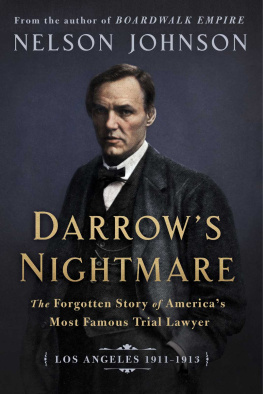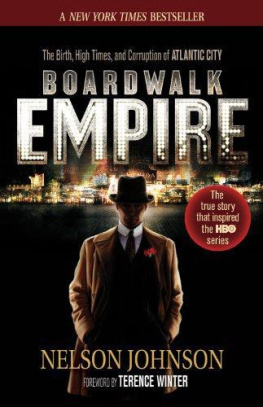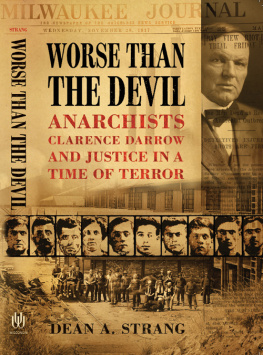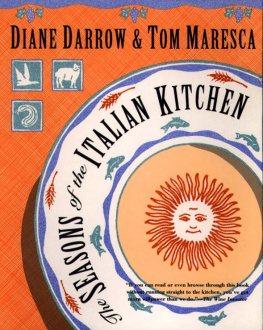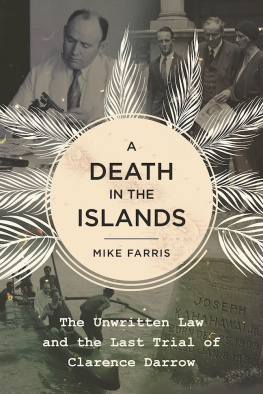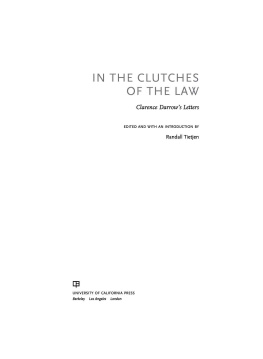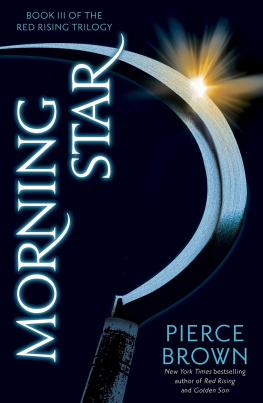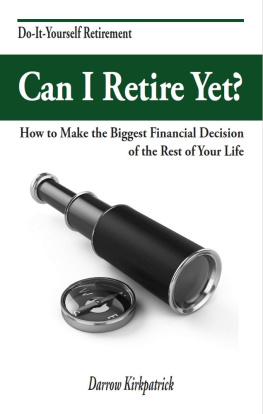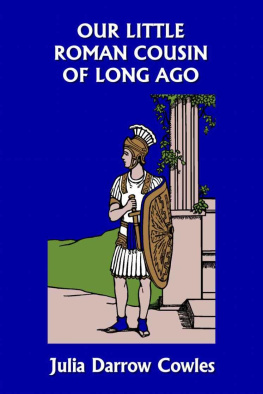Contents
Guide


Darrows Nightmare: Los Angeles 19111913
Copyright 2021 by Nelson Johnson
All rights reserved. No part of this book may be used or reproduced in any form or by any electronic or mechanical means, including information storage and retrieval systems, without permission in writing from the publisher. For information, please contact RosettaBooks at
.
First edition published 2021 by RosettaBooks
Jacket design by Mimi Bark
Interior design by Alexia Garaventa
ISBN-13 (print): 978-1-9481-2273-3
ISBN-13 (ebook): 978-0-7953-5301-7
Library of Congress Cataloging-in-Publication Data:
Names: Johnson, Nelson, 1948- author.
Title: Darrows Nightmare : Los Angeles 1911-1913 / Nelson Johnson.
Description: New York : RosettaBooks, 2021.
Includes bibliographical references and index.
Identifiers: LCCN 2020051601 (print) | LCCN 2020051602 (ebook) ISBN 9781948122733 (hardcover) | ISBN 9780795353017 (ebook)
Subjects: LCSH: Darrow, Clarence, 1857-1938.
LawyersUnited StatesBiography.
Classification: LCC KF373.D35 J64 2021 (print)
LCC KF373.D35 (ebook) | DDC 340.092 [B]dc23
www.RosettaBooks.com

To Johanna,
the love of my life who makes all I do possible.
THE PLAYERS

1. Clarence Darrow was brilliant, eccentric, and genuinely empathetic of the plight of the working poor, and anyone caught in the clutches of the law. Because of his many high-profile trials throughout his career, Darrow was the most widely recognized lawyer in the world. He was the subject of many biographies, films, and a Broadway play. Darrow was an old and tired fifty-four when he arrived in Los Angeles in the spring of 1911.
2. Ruby Darrow was proud to be Mrs. Darrow. She yearned no greater distinction. Twelve years younger, Ruby was a journalist when she and Clarence met. She saw the trajectory of Clarences career more clearly than anyone, and devoted herself totally to the man she believed would be remembered as the greatest lawyer in American history. Futilely, she resisted the trip to Los Angeles. Ruby understood long before Clarence that their stay in the City of Angels would become a nightmare.
3. Lincoln Steffens was Americas original muckraker. For nearly three decades, he was a leading investigative journalist, widely read in North America and Europe. Steffens is best known for his influential book Shame of the Cities , which prompted progressive legislation addressing the needs of the working poor. Yet he wanted to do more than to expose wrongdoings, he sought to improve the conditions of the downtrodden. Steffens and Darrow were close friends and confidants.
4. Earl Rogers, a Los Angeles attorney, was a charismatic, flamboyant, and troubled genius. As a trial lawyer, Rogers is credited by legal historians with having single-handedly brought more courtroom innovations to trial advocacy than anyone in American history. With an insatiable hunger for knowledge, he taught law in a medical school, and medicine in a law school. In addition to the law, he was a fashion trendsetter, his wardrobe the envy of Hollywoods movie stars. But for Rogers, Darrows career might have ended in Los Angeles.
5. The McNamara Brothers; John J. McNamara, aka J.J., was leader of the national Iron Workers union in Indianapolis, and was organized labors shining star. Smashing the roughneck stereotype, J.J. was well educated, articulate, and handsome. He was also a devout Roman Catholic with the smile of a choirboy. J.J.s younger neer-do-well brother, Jim was a foot soldier in the war between capital and labor. At J.J.s direction, Jim performed unspoken tasks for the Iron Workers union.
6. Harrison Gray Otis was the publisher/owner of the Los Angeles Times and during his reign, the Times was one of the loudest and most hostile voices against organized labor. Otis was a large, robust man and a leader, admired by men and women alike. He was a survivor of two wars, the American Civil War and the Spanish-American War, in which he was commissioned as a general. General Otis despised Clarence Darrow and everything that he stood for.
7. Harry Chandler was General Otiss son-in-law and eventually became the publisher of the Times. He continued Otiss anti-labor agenda but was a practical person. Acting in the best interests of the Los Angeles business community, Chandler worked with Lincoln Steffens in resolving the situation that originally brought Darrow to Los Angeles in the spring of 1911.
8. Felix Zeehandelaar, aka Zee, was an ally of General Otis. As executive secretary to the Merchants and Manufacturers Association, aka M & M, Zee played a key role in its development. During Zees reign, M & M became a war machine against organized labor.
9. Job Harriman was a socialist lawyer at the time General Otis held sway in Los Angeles politics. An active combatant in the battle between employers and organized labor, Harriman gave hope to the disenfranchised. He was, nominally, co-counsel with Darrow on the defense of the McNamara Brothers, and also a candidate for mayor of Los Angeles in 1911, a pivotal year in LA history.
10. Samuel Gompers was president of the American Federation of Labor and, during the early decades of the twentieth century, a respected voice of the organized labor movement. Gompers went to Chicago and pleaded with Darrow to accept representation of the McNamara brothers. Darrows time in Los Angeles marked the beginning of the end of his relationship with Gompers and organized labor.
11. Horace Appel was sui generis . A Mexican Jew with a vast command of accented English, Appel was also an experienced, brilliant, and savvy criminal trial lawyer who knew his way around the courtrooms of Los Angeles. Like Rogers, Appel was afflicted by unspoken demons.
12. Captain John Fredericks was a man of pride, energy, and conviction. Thrice elected Los Angeles County district attorney and a veteran of the Spanish-American War, rising to the rank of captain. Fredericks had his eye on becoming governor of California in the election of 1914. Though generally poised, when an angry nerve impulse struck the wrong synapse in his brain, his rage
was uncontrollable.
13. Joe Ford was deputy district attorney. He was an experienced and capable trial attorney but had a strength that was also a weakness: his aggressiveness. He could be like the dog who didnt know when to end the chase. A recent widower, and father of two young children, being a single parent atop his responsibilities as co-counsel with Fredericks was all consuming.
14. Judge George Hutton was a capable attorney who, in private practice, excelled in western water rights. In 1906, at the age of forty-two he was elected to the California Superior Court. Hutton had never practiced criminal law, yet there was no doubt as to his fairness, diligence, and strong sense of justice. Ultimately, Huttons interactions with Darrow were his undoing.
15. Detective John Harrington was a lawyer, investigator, and a shrewd operative whom Darrow had relied upon many times in the past in preparing for trial. He was a cagey investigator, able to quickly size-up a witness and make the most of their testimony. Darrow trusted Harrington completely and relied upon him in Los Angeles.

